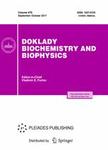版权所有:内蒙古大学图书馆 技术提供:维普资讯• 智图
内蒙古自治区呼和浩特市赛罕区大学西街235号 邮编: 010021

作者机构:Fed Med Biol Agcy State Res Ctr Burnasyan Fed Med Biophys Ctr Moscow 123098 Russia Russian Acad Sci Inst Gen Genet Moscow 119991 Russia
出 版 物:《DOKLADY BIOCHEMISTRY AND BIOPHYSICS》 (Doklad. Biochem. Biophys.)
年 卷 期:2025年第520卷第1期
页 面:96-100页
核心收录:
学科分类:0710[理学-生物学] 071010[理学-生物化学与分子生物学] 07[理学]
基 金:Burnasyan Federal Medical Biophysical Center of Federal Medical Biological Agency, (10.009.20.800) Russian Academy of Sciences, RAS, (0112-2019-0002) Russian Academy of Sciences, RAS
主 题:low doses of radiation Lewis carcinoma non-coding RNA oncogenes oncosuppressors mice
摘 要:Background. The effects of ionizing radiation (IR) involve a highly orchestrated series of events in cells, including DNA damage and repair, cell death, and changes in the level of proliferation associated with the stage of the cell cycle. A large number of existing studies in literature have examined the activity of genes and their regulators in mammalian cells in response to high doses of ionizing radiation. Although there are many studies, the research in effect of low doses of ionizing radiation remains limited. Though much progress has been made in understanding the basic principles of effects of low doses of radiation on individual components of biological systems, less is known about how low doses affect target molecules and regulate the cellular networks (e.g., activation of the immune system, genes and their regulators in the phenomenon of hormesis, and the formation of an adaptive response). These observations determined the purpose of the work: to investigate the activity of genes and non-coding RNAs (long non-coding RNAs and microRNAs) in various organs of mice with transplanted Lewis carcinoma after low-dose radiation. Materials and methods. Twenty-four female C57Bl/6 mice were transplanted subcutaneously with Lewis carcinoma cells (105 cells in 0.2 mL of Hanks solution). Total 4-fold X-ray irradiation with an interval of 4 days at a dose of 0.075 Gy (0.85 Gy/min) was performed on the RUST M1 from 6 days after transplantation;the tumor size was measured daily. The mice were divided into the following groups: Biocontrol, Biocontrol + irradiation, Tumor and Tumor + irradiation. On the 19th day from the beginning of the experiment, the mice were euthanized. The expression profiles of mRNA genes, long non-coding RNAs, and microRNAs controlling the response to radiation were determined in the bone marrow, thymus, spleen, and tumor of mice. Results. Fractionated low-dose irradiation of mice with transplanted Lewis carcinoma caused a growth decrease o